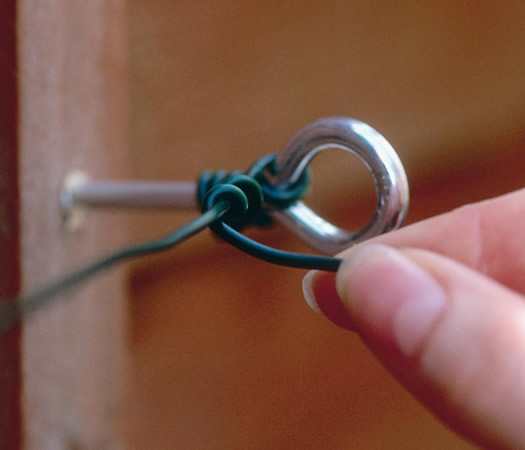If your objective is to cover a fence, post, trellis, wall or other structure or surface with a beautiful or handsome flowering or evergreen vine, you've come to the right place. We'll explore the various types of vines and how you can train them to grow on just about any type of support.
There are more than 20 ways vines climb, but most are variations on three basic methods: twiners, and vines that climb by tendrils or aerial rootlets that cling to surfaces, what I call "clingers." Below is a brief description of these.
Twining Vines
Twining vines, such as Jasmine, Honeysuckle and Wisteria, grow long shoots from the main trunk and branches that wind around some type of support structure. When growing on a chain link fence or a trellis they might not require any support, however, to grow them up a flat surface will require some sort of support structure.

How To Train A Twining Vine
Twining vines are easiest to grow on fences, arches, trellises, posts or pergolas and other overhead structures that have a network or symmetrical grid pattern of wooden, metal or plastic slats, which provide something for the vines to twine around. Their vines will also twine around the small branches and stems of large shrubs or trees. Just give the vines something to twine around and there's usually no need for support.
Note: To grow a twining vine up and over an arch, pergola or other overhead structure it will usually be necessary to use plastic tie tape to tie vines to the posts until they've grown up and over the top of the structure.
If you want to grow a twining vine against a wall, fence, or other smooth surface, some hardware will be necessary. The easiest way to grow a twining vine against a flat wall is with the use of a wooden, metal (preferably rust proof) or plastic trellis. Space the trellis or other support structure at least an inch away from the wall. I use a stretchy plastic tie-tape to train vines to the structure.
Alternatively, when planting a twining vine against a flat wall, you can use a weather resistant training wire and eyehooks in a symmetrical grid pattern to obtain full coverage of the wall, or any other pattern of your choosing. Space wires wires at least an inch from the wall using the eyehooks. The larger the vine grows at maturity the larger the wire and eyehooks should be. Training wire and hooks are available at your local nursery or hardware store.

When growing a twining vine up a wooden, masonry or metal post I usually string a wire from the top to the bottom of the post using nails, screws or eyehooks to attach the wires. Keep wires spaced at least an inch or more from the surface of the post.
Tendril Vines
A tendril is a specialized stem, leaves or petiole with a threadlike shape that is used by climbing vines such as Clematis and grape vines for attachment to structures or branches and stems of other plants, generally by twining around them.

Tendril vines are easiest to grow on fences, trellises, cages and other structures that have small slats, rods, wires, etc that the tendrils can twine around. These tendrils will also twine around the small branches and stems of large shrubs or trees. Just give the vines tendrils something to twine around and there's usually no need for support.
If you want to grow a tendril vine against a wall, fence or smooth surface, some hardware will be necessary. The easiest way to grow a tendril vine against a flat wall is with the use of a wooden, metal (preferably rust proof) or plastic trellis that has small slats, wires or rods.
Alternatively, you can use a weather resistant training wire and eyehooks in a symmetrical grid pattern to obtain full coverage of the wall, or any other pattern of your choosing. Space the wires at least an inch from the wall using the eyehooks. Training wire and hooks are available at your local nursery or hardware store. Space the trellis or other support structure at least an inch away from the wall.
When growing a tendril vine up a wooden, masonry or metal post of large diameter I usually string a wire from the top to the bottom of the post using nails or screws to attach the wires. Keep wires spaced at least an inch or more from the surface of the post.
Clinging Vines
Clinging vines, such as creeping fig, climbing hydrangea and trumpet vine, develop aerial roots along their branches and stems that naturally cling to walls and other surfaces. Clinging vines require no support. Just plant them near the base of a brick, stone or wood wall, tree trunk, or other suitable vertical structure surface, and they climb and cling all on their own.


